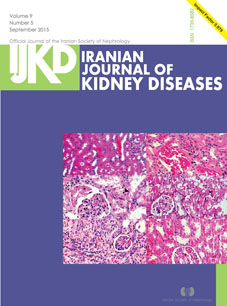The Role of Apelin 13 in Progression of Chronic Kidney Disease
Abstract
Introduction. Apelin is an adipokine secreted by the adipose tissue and by the endothelial cells in various parts of the body. Apelin is also expressed by the glomerular arteriolar rectus and glomerular capillary cells. We evaluated the relationship between the initial serum levels of apelin 13 with the trend of glomerular filtration rate (GFR) during a 1-year follow-up of patients with chronic kidney disease (CKD).
Materials and Methods. Ninety-nine patients with CKD in the predialysis stages were included and completed the study. The demographic data, medications, and comorbidities of the patients were recorded. The relationship between the baseline apelin 13 levels and the 1-year GFR loss was evaluated.
Results. The mean 1-year GFR loss 1.6 mL/min for those with CKD stage 3, 5.1 mL/min for those with CKD stage 4, and 2.6 mL/min for those with CKD stage 5. Fifty-eight patients (58.6%) had a GFR loss less than 5 mL/min and 41 (41.4%) had a GFR loss of 5 mL/min and greater, for whom the mean apelin 13 levels were 2169 ± 1807 mL/min and 2513 ± 1920 mL/min, respectively (P = .36). There was no significant correlation between the apelin 13 levels and GFR loss (P = .35).
Conclusions. To our knowledge, this study was the first that clinically examined the relationship between apelin 13 and CKD progression. Apart from the diabetic nephropathy, several factors causing comorbidity and progression may have probably masked this potential relationship.


